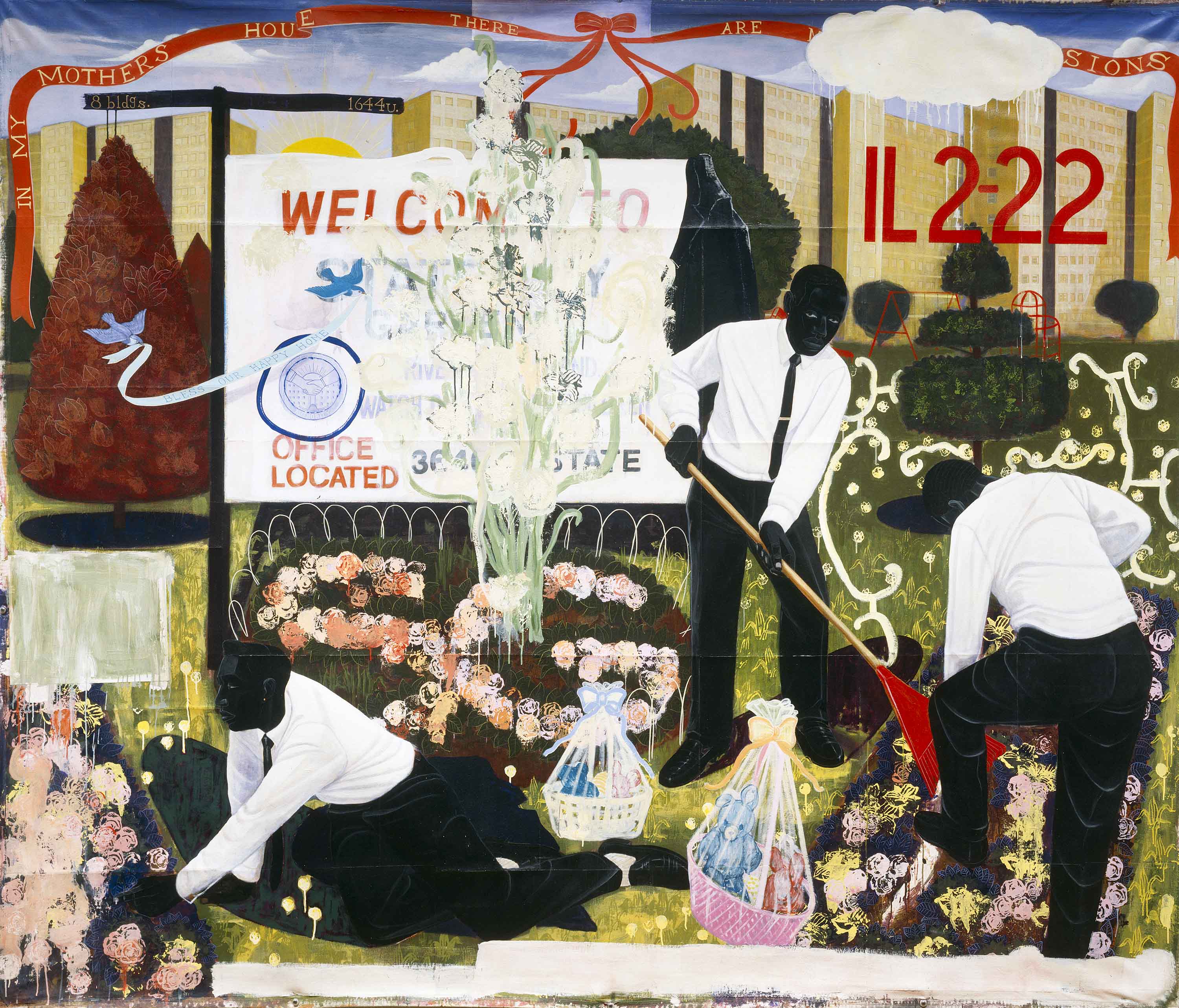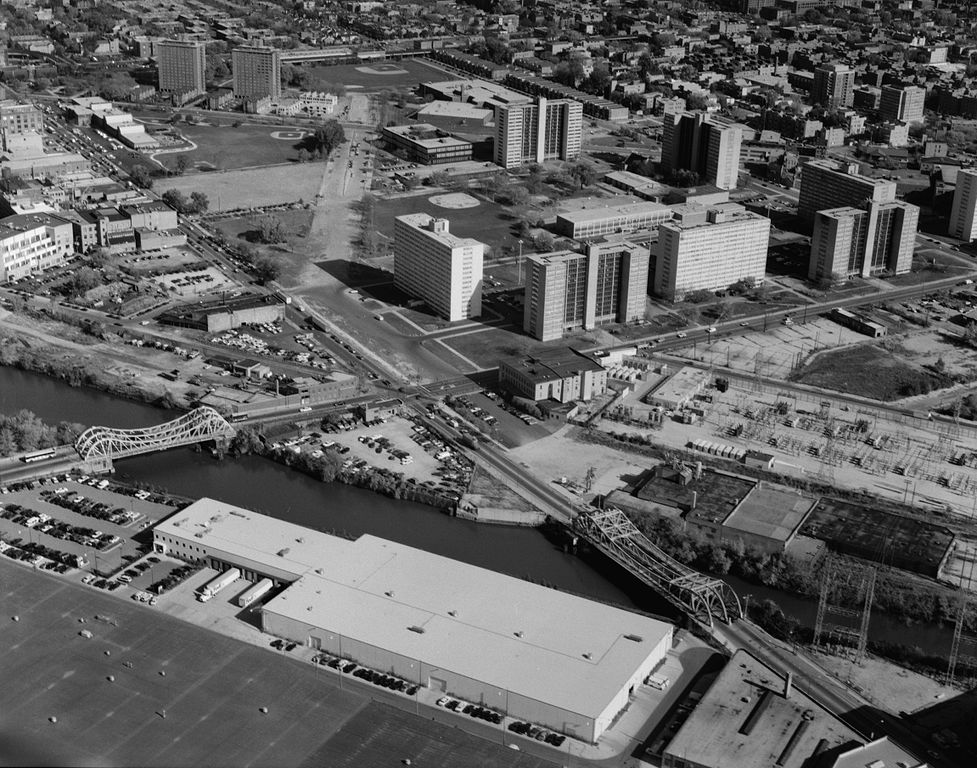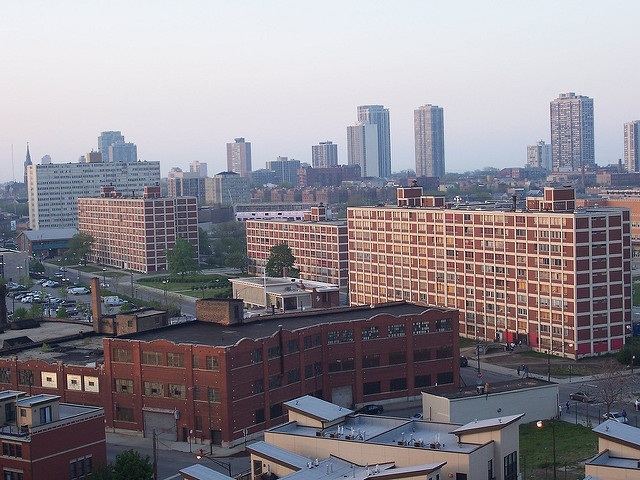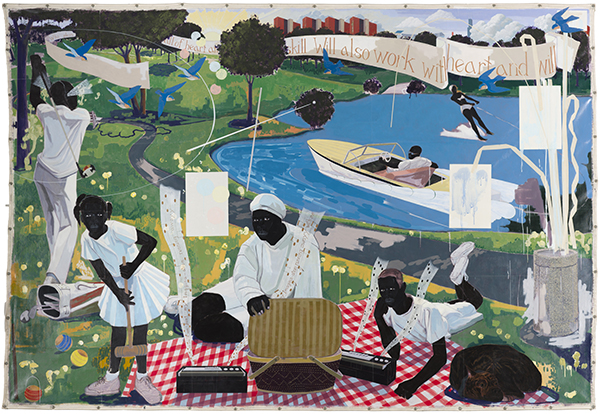
It was the turn of the millennium, and Cabrini was a disaster. Built in 1942 and expanded from the Francis Cabrini Row Homes to the greater, 3,600-unit Cabrini-Green public housing development over the next two decades, the site once heralded as a dream by residents, and which had replaced formerly dilapidated housing on the outskirts of the city’s fire limits, had, for all intents and purposes, reclaimed the former neighborhood’s pre-Cabrini appellation of “Little Hell” in the public eye.1
As the nation watched the buildings’ former promise swallowed by disrepair and violence in venues from news media to pop culture (see the 1992 horror film Candyman), former Chicago mayor Richard M. Daley galvanized its political imagination as he billed the city’s Plan for Transformation as a chance to “rebuild” residents’ “souls”—successfully pushing through his appeal for the federal aid necessary to execute the program despite the transition from the first Bush administration to the Clinton years, and even overriding the veto of Clinton’s secretary of Housing and Urban Development, Andrew Cuomo, with the power of his refrain.2 The Plan for Transformation, which began in 2000 and included the demolition of Cabrini, is still ongoing and indeed remains “the largest housing demolition and relocation project in the country, involving the rehabilitation or replacement of twenty-five thousand public-housing units and private-sector management of property and social services,” while the last building of “Little Hell” finally fell in 2011.3 But what exactly has been transformed by Chicago’s plan, and how can souls be rebuilt like buildings? How did Cabrini decline in the first place? These are questions that must be asked and that the scholarship is just starting to completely answer.
Previously, as with the almost tragically canonical story of St. Louis’s Pruitt-Igoe housing complex, Cabrini-Green’s modernist design scheme was often assigned a central role in its example of failed public housing. That school of thought has since shrunk from widespread acceptance, prompted by work such as The Pruitt-Igoe Myth (2012), which explains why and how such ideas are dangerous simplifications of a complex and abstracted historical imbrication of public housing design and systemically discriminatory housing policy. This essay extends from such thinking in its examination of the discursive discontinuities behind the Plan for Transformation, an examination that resituates the narrative of Cabrini by drawing on emergent scholarship with clear links to that new train of that thought—works such as Lawrence Vale’s Purging the Poorest: Public Housing the Design Politics of Twice-Cleared Communities (2013), Catherine Fennell’s Last Project Standing: Civics and Sympathy in Post-Welfare Chicago (2015), and Ben Austen’s High-Risers: Cabrini-Green and the Fate of American Public Housing (2018). Indeed, Cabrini-Green offers a perfect case study and extension through which to reevaluate public housing’s historical relationship to modernism—a choice merited by Cabrini-Green’s notoriety, the scale of Chicago’s Plan for Transformation, and the fact that its slab “Whites” (or the slab buildings of Cabrini’s William Green Homes) and the Promontory Apartments on Chicago’s South Side were both designed by the same firm, PACE Associates, guided by the tutelage of the legendary modernist architect Miës Van der Rohe, and similarly drawn from the “tower-in-a-park” concept first outlined by Miës’s predecessor, Le Corbusier.4 Though the former lies in rubble, the latter continues to thrive while nearing its seventh decade.

Vale’s book Purging the Poorest forms the analytical foundation from which my own analysis of Cabrini-Green will follow. Underscoring through the notion of “design politics” that a reconsideration of American public housing occasions more than just musing “on the power and limitations of architecture and planning” or “a sober exercise in policy analysis,” Vale pushes back against single-minded solutions by arguing that all examinations of public housing’s historical failures (and successes) should begin with a focus on how design and politics work reflexively.5 As I will argue, drawing on Vale’s book as well the recent work of Austen, Fennell, and others, the discriminatory public policy, real estate markets, and urban planning and design practices that shaped and operated through Cabrini-Green made it so that its modernist buildings, “built, owned, and managed with the aid of government,” as Elizabeth Wood, the former head of the Chicago Housing Authority who worked during the start of Cabrini, so astutely observed, “have stood as monuments to the government sanction of segregation.”6 Rather than functioning as an affordably constructed social safety net or an architectural channel of socioeconomic mobility, the austerity and isolated site layout of Cabrini-Green housing made it a potent force through which various discriminatory social and political forces could “other” Cabrini’s majority African-American residents. To begin to disentangle these problematic design politics of Cabrini-Green and other projects like it, we have to reinstate and resituate the black resident-subject most centrally and adversely acted upon by these twinned forces—the actual “soul” at the nexus of such issues, not the projected “souls” set up so tantalizingly in Daley’s rhetoric.
By 1950 Cabrini-Green’s demographics had inverted to 80 percent black, a shift prompted by racial anxieties, the razing of black homes via the “urban renewal” section of the 1949 Housing Act, and the “two-headed housing policy” that made purchasing suburban homes affordable to whites (and only whites) looking to move out of the city.7 The neighborhood also became increasingly and concentratedly poor, despite an auspicious start as the majority racial makeup of residents switched. From Vale:
Even with the depopulation and massive white flight of Chicago that accelerated in the 1950s and extended for decades, Wood and Taylor maintained racial quotas to hold their integrated ideal, at one point passing out flyers promoting the development to potential white residents for fear of what de-integration could do to Cabrini-Green’s future and current prospects.8 These efforts proved for naught and, by the 1970s, further diminished economic opportunity via the loss of manufacturing and industry, the imposition of pro-rated rents, and increased crime prompted middle- and working-class black families to leave Cabrini-Green as well.9 Formerly thorough screenings for entry and the range of resident social services fell off; income requirements and rent rolls sank with the passage of the pro-rating 1968 Brooke Amendment, plummeting revenues combined with cuts in federal funding to reduce maintenance to nil. These policy shifts, as Vale points out, worked with and magnified themselves through Cabrini’s design.

The open-air corridors with panoramic views (“sidewalks in the air”), once touted as social amenities, were fenced over; elevators stopped functioning, and uncleaned hallways were left covered in graffiti and detritus. Grass gave way to blacktop, the creamy vanilla exteriors stained ochre and gray.10 Despite the fact that a “security pilot program” implemented in Chicago after the doom-saying demolition of St. Louis’s Pruitt-Igoe project showed a “25 percent reduction in crime, a 38 percent drop in vandalism costs, and a 27 percent increase in tenant employment” as well as lowered vacancy rates in Cabrini-Green, widespread TV reports on the project’s crime and the dramatic images of unrepaired units and police and gang members battling in the towers led to Cabrini-Green’s writing off as a “civic disgrace.”11 With access to recreation and commercial activity already restricted by the vast openness of Cabrini-Green, these practices of policy, media, and (neglected) design hid the quotidian, normal activities of the majority of residents living within the towers and spat back out a skewed projection of those abstracted inside the austere façades. In a feedback loop, African Americans within Cabrini-Green were stripped of their subjectivity through the activated austerity of modernist design and the tower-in-a-park’s isolation, while a manufactured “other,” the hopeless black public housing resident, was written back into the blank façades and projected to the public.
Cabrini-Green did have its moment in the sunlight. Despite the conflicts raised by its racial and economic integration, people had once desired to live there, and the project was described as a dream, a “leap into the middle class.”12 Aspiring, middle- and working-class black families who had arrived at the start of the project without any other satisfactory residency options to turn to (due to housing discrimination) had reveled in the majesty of their “lordly” views of the Chicago skyline, breezy mosquito-less walkways, and powerful heating systems.13 Kerry James Marshall, a former public housing resident himself, captures that ephemeral, but stolen, sense of opportunity and possibility held by black Chicago public housing residents in his paintings Many Mansions (1994) and Past Times (1997). These works portray a more idyllic sense of what the tower-in-a-park public housing had once been and could be but wasn’t: blooming flowers, manicured lawns, birds flying in sunny skies that almost twitter from the canvas, a picnic and music and images of black subjects at leisure (cricketing, golfing, swimming, water-skiing), with the towers lingering far in the background. Following bell hooks’ book Black Looks, in which she states that “Unless we transform images of blackness, of black people, our ways of looking and our ways of being seen, we cannot make radical interventions that will fundamentally alter our situation,”14 Marshall re-asserts and reclaims public housing as a site of subjectivity on behalf of black residents in his paintings, visually inverting the centrality of modernist buildings to residents and place in visual discourse. To draw from Foucault writing on architecture:
Modernism is a form while liberty is a practice—it involves something more than just the built form and requires activation. While narratives condemning public housing instrumentalize modernist design in their claims regarding its nigh-inevitable failure, Marshall pushes back through the same architectural conduit to resituate the narrative of public housing, its residents, and in our case, Cabrini’s decline.

By the time of former Chicago mayor Richard M. Daley’s millennium Plan for Transformation, the design politics of Cabrini-Green had succeeded in not only stripping residents of their subjectivity but also in conflating residents’ agency with the effects of discriminatory public policy, social injustice, and architecture, abstracting the narrative of greater racial systems of oppression that cast many residents into housing crises in the first place. Cabrini, as Deirdre Pfeiffer writes, became “a discursive site, a space marked by ‘cultural production and political struggle.’” In an analysis of discourse regarding Cabrini, Pfeiffer charts a random sample of public housing building descriptions that include “isolated,” “notorious,” “oppressive,” “a symbol of failure,” “dangerous,” and “deteriorating,” and descriptions of public housing tenants within the same survey draw provocative parallels: like the buildings, residents are “socially isolated,” “casualties,” “opposed,” and “in poor shape.”15
Importantly, many of these mistaken associations occur in the realm of the visual, for the visual, according to both hooks and Fanon, is the primary cultural tool for racial othering and the denial of the black subject.16 From Fanon:
The eye is a singular mirror, bestowing upon itself subjectivity, an action it performs by establishing the other as something that needs to be “corrected.” In this case, not the actors and the design politics behind Cabrini and its failures but the buildings themselves and the abstracted residents contained within. Through commanding design politics, discriminatory systems of power (the state, media) overrode all else to “correct,” or remove, any presence of the undesired black subject, and to create the black other as a precursor to excision. Kerry James Marshall’s paintings Many Mansions and Past Times are so powerful precisely because they disrupt this erasure of the black subject by reclaiming black subjectivity through the very visual system—architecture—used to deny it in the first place. By re-asserting the black resident-subject, Marshall unveils systems of oppression abstracted within the austere isolation of towers-in-a-park like Cabrini. He operates Foucault’s paradigm in reverse.
A visual comparison of two recent photos—one of a dilapidated “White” in Cabrini-Green, and another recently published in the New York Times that shows a “White” partially demolished, bleeding in Technicolor from a crumbling side profile—offers a similarly powerful reassertion of the resident-subject within Cabrini-Green.17 The dilapidated version of the “White,” sealed off from the outside by an island of demapped through-streets and fenced-over “sidewalks in the air,” serves as an abstract representation of failure, and we are not invited to see the vast initiative and differentiated personalities shielded from the outside by the austere exterior of the building. The subjectivity denied by the “Whites” and the design politics of their modernist tower-in-a-park plan, however, meet rupture in the second photo. There, in a demolished cross-section, interior walls howl out the individual subjectivities of residents, whose ghosts linger in lovingly painted hues of magenta, periwinkle, teal, and copper. Past Times, exactly.
By the omission of adequate design politics, then, the plan risked merely transforming Cabrini’s erasure and replacement of the public housing subject, failing again, albeit in novel fashion. The Plan incorporated traffic, excitement, and spontaneity, and re-invited public inspection but for a select subject and at the cost of former Cabrini residents, whose subjectivities were left covered once more by the patina of urban renewal.18 Currently, less than three thousand Chicago Housing Authority families are housed in the Plan for Transformation’s mixed-income developments in total across the city—representing less than the maximum population of Cabrini-Green.19And while vouchers were one way the city sought to address this lack of redevelopment, so arrives another failure on the policy side of Vale’s paradigm: In 1995, total property sales within a two-block radius of Cabrini-Green totaled $6 million; from 2000 to 2005, they totaled almost $1 billion—more than 150 times the 1995 amount.20
When Vale writes of Cabrini as a place “twice demolished,” he underlines the great irony of public housing’s history. As he explains, design politics “compartmentalize” the larger intra-race and intra-class issues of public housing, abstracting “underlying institutions of an equal society” so that policymakers can more easily replace “one dysfunctional community with a more carefully designed alternative.” Rebuilding proves “an exercise in excision as much as it is an act of building” while the racialized and classed “other” is both rehabilitated and re-created through a twisted cycle.21 By ignoring how design and politics work in concert to erase, abstract, and oppressively act upon residents-subjects, we fail to create lasting public housing solutions.
The Plan for Transformation will not solve Cabrini’s issues alone, any more than a new policy will solve Cabrini’s social and racial inequality without adequate physical architecture and design. Similarly, to blame modernism for public housing’s failures, or to champion revolutionary design as the path to future success despite unstable policy, is a fallacious simplification shouted from the opposite side of a bow compass circumscribing repeated failure—a failure that requires attention to the forgotten public housing resident-subject reasserted by Kerry James Marshall and other artists, activists, and organizations (like Chicago’s National Museum of Public Housing) to avoid its repetition. By such re-examination, we can perhaps better read the complex narrative of public housing’s modernist history into a more promising future instead of finding ourselves once more in the unsavory position so poignantly captured in the opening of Chicago poet Gwendolyn Brooks’ “In the Mecca”:
Sit where the light corrupts your face.
Miës Van der Rohe retires from grace.
And the fair fables fall. 22
-
Lawrence J. Vale, Purging the Poorest: Public Housing and the Design Politics of Twice-Cleared Communities (Chicago: University of Chicago Press, 2013), 157; Ben Austen, High-Risers: Cabrini-Green and the Fate of American Public Housing (New York: Harper Collins, 2018), 22, 46–47. ↩
-
Vale, Purging the Poorest, 286. ↩
-
John Betancur, Karen Mossberger, and Yue Zhang, “Standing in Two Worlds: Neighborhood Policy, the Civic Arena, and Ward-Based Politics in Chicago,” in Urban Neighborhoods in a New Era: Revitalization Politics in the Postindustrial City, ed. Clarence Stone and Robert P. Stoker (Chicago: University of Chicago Press, 2015), 89. ↩
-
Both designs were simple, presenting from one side “a large rectangular slab raised off the ground by a series of columns,” and, from the other, “a more conventional courtyard elevation” with “creamy vanilla” exteriors checkered by weather-sealed, double-paned windows, and both drew from Mies’s work. See Carsten Krohn, Mies van der Rohe—The Built Work (Basel: Birkhaüser, 2014), 148; and Austen, High-Risers, 225. ↩
-
Vale, Purging the Poorest, 1. ↩
-
Elizabeth Wood, Social Planning: A Primer for Urbanists (New York: Community Education Program by the Planning Department of Pratt Institute, 1965), 29.
When the Cabrini rowhomes went up, the neighborhood that pre-existed the site consisted of 80 percent white residents and 20 percent black residents—the latter number being singularly high for Chicago’s northern neighborhoods at the time.[^7] Though much of Chicago’s public housing, which was most needed by African-American families, would be placed in the predominantly black South Side, Chicago Housing Authority officials Elizabeth Wood and Robert Taylor saw an opportunity for social change in the neighborhood’s makeup. Wood and Taylor believed in the necessity of mixed-income and mixed-race housing integration to ensure greater socioeconomic flourishing, but Interior Secretary Harold Icke’s “neighborhood composition rule,” pre-existing practices of discrimination in private real estate markets, and mob violence against blacks moving into white neighborhoods made executing that ideal almost impossible.[^8] Cabrini-Green, to the joy of Wood and Taylor, held the potential of an exception, yet Cabrini-Green’s slide into decrepitude provides an almost textbook model of how tower-in-a-park public housing’s risks of racial othering came to a nefarious head. ↩ -
Austen, High-Risers, 32; Catherine Bauer, “The Dreary Deadlock of Public Housing,” Architectural Forum, vol. 106, no. 5 (May 1957): 219.
In 1950, Cabrini’s tenant incomes were still about 60 percent of the Chicago area median—demonstrably “poor” but exhibiting nothing like the extreme poverty of many in the city. In 1950, black CHA tenants had incomes close to the median of black Chicagoans as a whole, a far cry from the extreme and plummeting poverty that would engulf CHA residents after 1970.[^10]
-
Austen, High-Risers, 33. ↩
-
Austen, High-Risers, 98. Overcrowding in prisons and the federal legislation that gave those in dire economic straits priority in public housing placed young and disadvantaged members of rival gangs—stripped by the heavy hand of Richard J. Daley of leaders who attempted efforts at peace and conversions into community organizations in the 1960s and 1970s—into close contact with one another, provoking waves of crime through the insidious disregard for gang relations. ↩
-
Vale emphasizes the design politics of this transition in particular, calling the paving over of fields “a symbolically resonant symbol of decline” to Cabrini residents. As he also adds, such “design decisions and social tensions mutually reinforced each other, creating a deeply destructive element of mistrust.” Vale, Purging the Poorest, 31. ↩
-
Austen, High-Risers, 83, 139. ↩
-
Austen, High-Risers, 21. ↩
-
Austen, High-Risers, 25–26. ↩
-
bell hooks, Black Looks: Race and Representation (New York: Routledge, 2015), 7.
I do not think that there is anything that is functionally—by its very nature—absolutely liberating. Liberty is a practice. So there may, in fact, always be a certain number of projects whose aim is to modify some constraints, to loosen, or even to break them, but none of these projects can, simply by its nature, assure that people will have liberty automatically, that it will be established by the project itself.[^18]
-
Deirdre Pfeiffer, “Displacement through Discourse: Implementing and Contesting Public Housing Redevelopment in Cabrini Green,” Urban Anthropology and Studies of Cultural Systems and World Economic Development, vol. 35, no. 1 (Spring 2006): 40, 55. ↩
-
“From slavery on, white supremacists have recognized that control over images is central to the maintenance of any system of racial domination.” hooks, Black Looks, 2.
The eye is not only a mirror, but a correcting mirror. The eye most enables us to correct cultural mistakes. I do not say the eyes; I say the eye—and we know what the eye reflects: not the calcarine fissure, but the even glow that wells up out of van Gogh’s reds, that glides from a Tchaikovsky concerto, that clings desperately to Schiller’s “Ode to Joy,” and lets itself be carried away by Césaire’s vermiculate howl.”[^21]
-
For the first image, see David Schalliol’s photograph in Jonathan S., “Developer Plans 482 Apartments, Condos on Former Cabrini-Green Site,” Time Out Chicago (February 2017), link. The second can be found in Ben Austen, “The Towers Came Down, and with Them the Promise of Public Housing,” the New York Times Magazine (February 2018), link.
Perhaps it is better to say then, that Daley did not want to rebuild souls but to entirely construct new souls—or resident-subjects—with the sweeping Plan for Transformation.[^23] Ironically, the planned (re)establishment of a new Cabrini-Green performed this task through a design that included all the things Elizabeth Wood so desperately fought for in her original CHA developments but that were erased by the 1949 Housing Act that imposed new levels of building austerity while using federal dollars and urban clearance provisions to reshape entire neighborhoods.[^24] Inspired by New Urbanism, the plan erected mixed-income housing scattered across midrises and townhomes organized amid a mélange of retail space and public parks, creating what William Whyte later called “a multisensory street,” or what Wood expressed in her original desire for the incorporation of “commercial recreation” into public housing.[^25] But here, again, problematic design politics made a sweeping incursion. While former Cabrini residents were given a 30 percent stake in the new venture, they were often left out of the design process for the site and had to sue in order to get a seat at the table.[^26] Meanwhile, the plan skewed toward the preferences of market residents, staging a new “sympathetic civics of everyday life” that favored “normative expectations concerning property, security, work, and responsibility.”[^27] This imbalance disrupted the assumed possibility of social integration, already thrown into question by the mixed results of New Urbanism’s core belief that sheer spatial proximity will brook all socioeconomic divides. As noted by Fennell: ↩ -
The website for the real estate company Dream Town provides a helpful way to index this new subject. As found on the Cabrini-Green section of the company’s website, “Nestled among some of the city’s most sought-after neighborhoods, Cabrini-Green has long been targeted as a prime Chicago location. Now, row after row of new construction townhomes and condominium developments are replacing the rundown residences of yesteryear making Cabrini-Green a hidden gem that is still hovering under the radar. Forward thinkers are taking advantage of the neighborhood’s top properties and getting in before the transition is complete and real estate prices shoot up.” ↩
-
Austen, “The Towers Went Down.” As Austen also notes, the CHA now oversees sixteen thousand units of occupied public housing, compared to the former thirty-eight thousand units it held in 1999, as well as forty-seven thousand vouchers in the private market. Combined, these make for more units than the CHA’s stock in the 1990s but do not account for the discrimination voucher holders and mixed-income development public housing residents face. ↩
-
Austen, High-Risers, 277. ↩
-
Vale, Purging the Poorest, 261–262. ↩
-
Gwendolyn Brooks, In the Mecca (New York: Harper and Row, 1968), 18. Though “the Mecca” was a private apartment building, its demolition was justified as slum clearance to make way for the urban renewal of the Illinois Institute of Technology campus designed by Mies Van der Rohe. ↩
Bo McMillan is a second-year doctoral student and writer in Columbia’s Department of English and Comparative Literature whose work focuses on the intersections of urban planning, architecture, real estate, and literature. He profoundly thanks Professor Mario Gooden for all of his guidance and influence on this piece, which most certainly extends from his book, Dark Space, and the course of the same name that he teaches at Columbia’s Graduate School of Architecture, Planning, and Preservation.

